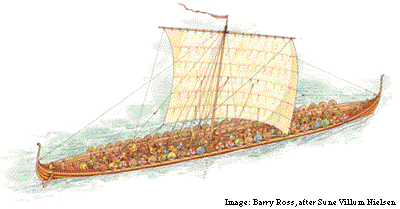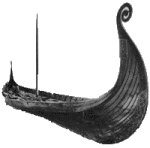
The Norse

 |
|
|
 Ancient Scandinavia was dominated by speakers of North
Germanic languages, including Old Norwegian, Old Swedish, Old Danish, and Old Icelandic.
Scandinavians did not participate in the first wave of Germanic migrations that destroyed
the Roman Empire, but in the eighth century some of them initiated a second wave of Viking
invasions.
Ancient Scandinavia was dominated by speakers of North
Germanic languages, including Old Norwegian, Old Swedish, Old Danish, and Old Icelandic.
Scandinavians did not participate in the first wave of Germanic migrations that destroyed
the Roman Empire, but in the eighth century some of them initiated a second wave of Viking
invasions.
The typical Viking was a landless young man who made a living as a pirate, sometimes
preying on other Scandinavians as well as peoples farther south. Most Scandinavians were
farmers or traders who regarded Vikings with grave suspicion, and in the early literature
Vikings often come across as arrogant louts who brag too much about their exploits abroad.
Contrary to popular belief, Vikings did not wear horned helmets, though some of their
armor is decorated with representations of earlier Germanic warriors wearing such helmets.
The term Viking invasion is sometimes used for attacks by large fleets of ships under the
command of an aristocrat who would probably not have been called a Viking by his fellow
Scandinavians, at least not to his face.
Study of Old Norse texts is especially informative about early Germanic culture because
the Scandinavians were converted to Christianity much later than the East and West
Germanic peoples (around 1,000 AD). By this time, Roman Christianity was well established
in Western Europe and no longer felt much threatened by the few remaining traces of
pre-Christian thought. Norse mythology could be used as ornamental material in
Scandinavian poetry without offense, much as pagan Greek and Roman mythology was used by
the deeply religious John Milton to ornament his Christian epic, Paradise Lost.
Particularly valuable for the study of pre-Christian myth is a treatise by the poet and
historian Snorri Sturluson, which presents Germanic mythology in a clear and
comprehensible way for the instruction of younger poets. This treatise, called the Prose
Edda, allows for consistent interpretation of the old poems and sagas from which Snorri
drew his information, many of which can be dated to the pre-Christian era. The early Norse
poems are consistent, in striking detail, with each other and with Snorri's general
survey, so they cannot have been much affected by Christianity.
The warrior maiden Brunhilde (sometimes referred to as a Valkyrie) plays a conspicuous
role in the earliest heroic legends of Scandinavia. Her martial role can be validated in
the archaeological record, since female warriors were given a distinctive style of burial
with weapons. The default gender for chieftains was male, but women could also serve in
this capacity. An example well documented in the historical record is Aud the Deep-Minded,
chieftain of the Salmon River Valley district in Iceland.
A wealth of prose sagas survives in Old Norse. These employ an intricate
"realistic" style that offers a valuable supplement to heroic literature, which
tends to abstract away from everyday life and focus on generalized traits of character
under imaginary conditions of extreme stress. Modern Iceland preserves many traits of
early Scandinavian culture due to its geographical isolation from continental Europe. The
Icelandic language has changed so little since Old Norse times that it is easier for a
present-day Icelander to read ancient sagas than for the average American to read
Shakespeare.
![]() The Viking
Home Page.
The Viking
Home Page.
![]() The
Viking History Web. These are the two best sites that I found about the Vikings. The
Viking History Web is especially good for its background information on the Vikings, as
well as other more esoteric material. Plenty of pictures as well. It also has a Church Web
and a Royals Web (for the major European royal houses). Lots of fun.
The
Viking History Web. These are the two best sites that I found about the Vikings. The
Viking History Web is especially good for its background information on the Vikings, as
well as other more esoteric material. Plenty of pictures as well. It also has a Church Web
and a Royals Web (for the major European royal houses). Lots of fun.
![]() The Bifrost Project.
Loads of links to other Viking, Anglo-Saxon, Celtic, and Norse pages, not to mention some
totally irrelevant but definitely interesting pages.
The Bifrost Project.
Loads of links to other Viking, Anglo-Saxon, Celtic, and Norse pages, not to mention some
totally irrelevant but definitely interesting pages.
![]() Viking Navy.
Reconstruction of a Viking Navy. Great pictures available here.
Viking Navy.
Reconstruction of a Viking Navy. Great pictures available here.
![]() The
Vikings: They Got Here First, But Why Didn't They Stay? Very interesting project to
prove that Norse explorers had discovered North America 500 years before Columbus.
The
Vikings: They Got Here First, But Why Didn't They Stay? Very interesting project to
prove that Norse explorers had discovered North America 500 years before Columbus.
![]() The
Norse and Inuit History of Southern Greenland. It's actually part of a "travel
Greenland" page, but it's still interesting.
The
Norse and Inuit History of Southern Greenland. It's actually part of a "travel
Greenland" page, but it's still interesting.
This stuff is fascinating. Great sagas, warriors, towering magic (does magic actually tower? one of those metaphor things), the story of the gods. It's wonderful. It's like Tolkien, only better because I think Tolkien actually used a lot of these legends in his writing. I'm going to dig out The Lord of the Rings after this.
![]() The Life and
Death of Cormac the Skald ("Kormak's Saga").
The Life and
Death of Cormac the Skald ("Kormak's Saga").
![]() Heimskringla
("The Chronicle of the Kings of Norway").
Heimskringla
("The Chronicle of the Kings of Norway").
![]() The Saga of
Grettir the Strong ("Grettir's Saga").
The Saga of
Grettir the Strong ("Grettir's Saga").
![]() The Story of Burnt
Njal ("Njal's Saga").
The Story of Burnt
Njal ("Njal's Saga").
(All the above sites are from The Online
Medieval & Classical Library. They have got tons of medieval texts: Latin,
Anglo-Saxon, you name it.)
![]() The
Elder Edda - The Prose Edda - The Norse Sagas. The most famous Norse sagas! Snorri
Sturluson! Go read! Read!! Read!!! (I've read somewhere that multiple exclamation marks
are a sign of insanity...)
The
Elder Edda - The Prose Edda - The Norse Sagas. The most famous Norse sagas! Snorri
Sturluson! Go read! Read!! Read!!! (I've read somewhere that multiple exclamation marks
are a sign of insanity...)
![]() Barbarian's Page of
Norse Paganism. Great descriptions and pictures of the religion of the Norse, as well
as an interesting exposition on how paganism has been altered to suit the needs of people
like Adolf Hitler. Also loads of links. Highly recommended.
Barbarian's Page of
Norse Paganism. Great descriptions and pictures of the religion of the Norse, as well
as an interesting exposition on how paganism has been altered to suit the needs of people
like Adolf Hitler. Also loads of links. Highly recommended.
![]() Norse
Mythology. FAQ on Norse mythology. The author claims it's still under construction,
but it has a pretty good list of sources for Norse mythology
as it is.
Norse
Mythology. FAQ on Norse mythology. The author claims it's still under construction,
but it has a pretty good list of sources for Norse mythology
as it is.
![]() German 1500.
It's actually a course syllabus, but it has a great list of on-line Germanic myths,
legends and sagas.
German 1500.
It's actually a course syllabus, but it has a great list of on-line Germanic myths,
legends and sagas.
![]() Norse
Mythology. Some background material. Also has a page on runes.
Norse
Mythology. Some background material. Also has a page on runes.
![]() A Web of
Futhark!! Showing the Norse Runes and their history. Pretty interesting.
A Web of
Futhark!! Showing the Norse Runes and their history. Pretty interesting.
![]() Norse-related
stuff. This is a collection of Rialto (rec.org.sca) articles. Strange at times, but
still interesting. For instance, there's an article on what the Norse ate, as
well as one on boardgames
played by the Norse. Must have been those long winters...
Norse-related
stuff. This is a collection of Rialto (rec.org.sca) articles. Strange at times, but
still interesting. For instance, there's an article on what the Norse ate, as
well as one on boardgames
played by the Norse. Must have been those long winters...
![]() The Vikings: Norse Film and
Pageant Society
The Vikings: Norse Film and
Pageant Society
![]() The Anglo-Saxons
The Anglo-Saxons
![]() The Celts
The Celts
![]() Back to the main page
Back to the main page